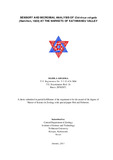Please use this identifier to cite or link to this item:
https://elibrary.tucl.edu.np/handle/123456789/1373| Title: | Sensory and Microbial Analysis of Chirrinus Mirgala (Hamilton, 1822) At the Markets of Kathmandu Valley |
| Authors: | KHADKA, MABILA |
| Keywords: | Sensory analysis;Microbial loading;Chrrinus mirgala |
| Issue Date: | Jan-2017 |
| Publisher: | Central Department of Zoology Institute of Science and Technology Tribhuvan University Kirtipur, Kathmandu Nepal |
| Abstract: | Fish meat is an excellent source of long chain omega 3 polyunsaturated fats, riboflavin, pantothenic acid, selenium and vitamin D and is low in fat and sodium. Meat is highly perishable food as it is an ideal culture medium for growth of many organisms because of the high moisture, high percentage of nitrogenous compounds of various degree of complexity, plentiful supply of minerals, accessory growth factors and some fermentable carbohydrates (glycogen) of a favorable pH for most of the enteric microorganisms. The development of various spoilage indicators in fish and fish products is due to a combination of microbiological, chemical, enzymatic and physical phenomena. This research objects the sensory and microbial Analysis of Chirrinus mirgala at the markets of Kathmandu Valley. Two hundred twenty five samples collected randomly from 5 stations in the time period of March 2016 to June 2016 were examined for sensory and microbial analysis. Sensory analysis was performed by the Quality Index Method. For microbial analysis, enumeration of total bacterial load in gills, muscle and intestine along with examination for the presence of Salmonella spp. in samples was performed. Standard microbiological techniques were used for the preparation of media, isolation and identification of the microbes. Pour plate technique was employed for enumeration of total bacterial load. The Quality Index for the samples was in increasing order for Kalimati, Balkhu, Lagankhel, Khicchapokhari and Bhaktapur with the value of 6.3, 7.0, 7.7, 8.7 and 11 respectively. The microbial load in the edible portions (muscle and head with gills) of Chirrinus mirgala had the lowest value 1.51 X107 for the samples from Khicchhapokhari and highest microbial load was found in the samples of Bhaktapur with the value 3.33 X109. Microbial loading was found to be the highest in intestine and the least in muscles. Salmonella spp. was found in the intestine of samples but not in the muscle and gills. Though Sensory analysis results of samples inferred that the fishes are not evidently spoiled to reject for the consumption and Salmonella spp. was isolated only from the inconsumable body parts, the high microbial loading recommends further examination of fish especially for the presence of pathogens, during handling, storage and up to the very point of consumption is needed for the protection and maintenance of community health by keeping food borne diseases to a minimum. |
| URI: | http://elibrary.tucl.edu.np/handle/123456789/1373 |
| Appears in Collections: | Zoology |
Items in DSpace are protected by copyright, with all rights reserved, unless otherwise indicated.

